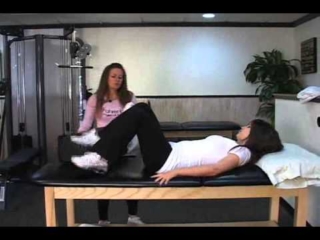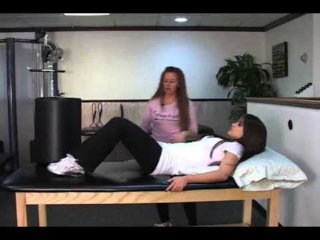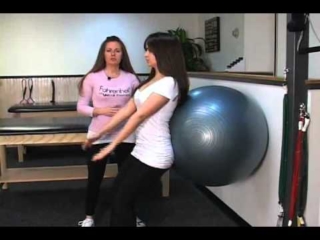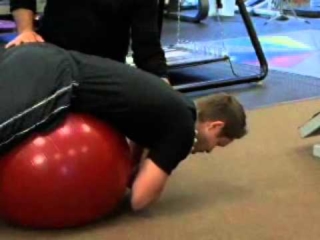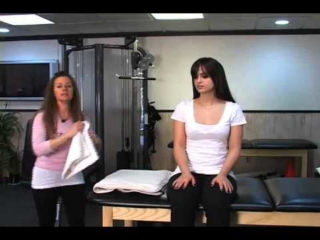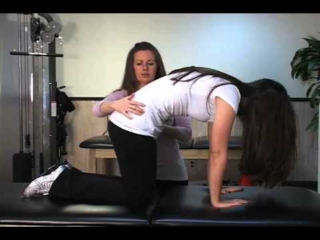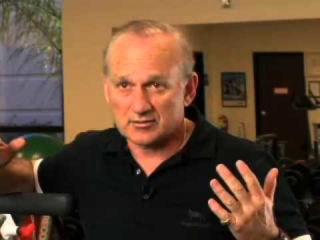Back strain
Last Updated on August 12, 2024 by The SportsMD Editors
Most athletes will have a minor back problem or back strain at one time or another. Muscle strains are the most common causes of low back pain. A low back strain occurs when the muscle fibers are abnormally stretched or torn. For example, back muscle strains can occur during sports, recreational activities and after sudden movements in sports. They can also occur while lifting heavy objects and even normal household items.
Why are back muscles subject to strain?
The muscles that move the spine are not large muscles grouped together, but rather a large contingency of very small, individual muscles layered and aligned to produce contractions of varying intensities. Because they are small, they are more at risk for injury.
Who gets a back strain?
 A back strain is common in athletes and the general population with a great deal of research being spent on how to better understand the mechanics of lifting for the purpose of preventing these injuries.
A back strain is common in athletes and the general population with a great deal of research being spent on how to better understand the mechanics of lifting for the purpose of preventing these injuries.
The back muscles are placed at risk for strain when an individual starts in any combined positions of flexion, lateral flexion, and rotation and then extends and rotates the spine back into a neutral position. Sports that involve repetitive hyperextension, jumping (compressive loading from the landing), and twisting can place athletes at risk for back strain. These sports include gymnastics, basketball, wrestling, tennis, golf, and rowing.
Classifications of muscle strains
Classifications of muscle strains are divided into three categories including minor (first degree), moderate (second degree), and severe (third degree).
First degree back muscle strains:
Are the most common and involve either overstretching or minor tearing of one or more muscle fibers. Because the injury is mild, the individual is typically functional (can move the spine) but with some discomfort. Increased movement exacerbates the pain and may lead to localized muscle spasm. There may also be some weakness in the muscle that has been strained.
Second degree back muscle strains:
Involve a partial tear of one or more muscles. Because the tear is greater in a second degree, the symptoms of the injury are more pronounced. The individual may be guarded in all back movements due to muscle spasm. All movements are affected and may be limited in all directions. The pain is significantly greater both because of the torn tissue and the associated muscle spasms. With a back strain, the individual may have significant difficulty standing, sitting, and lying down. Because the muscles responsible for spine extension are used any time the body is in movement, all movements may be guarded and painful.
A third degree back muscle strain:
Involves a complete tear of one or more muscles. The tear may either be in the muscle or at the musculotendinous junction (common location for a rupture). Significant muscle tears may have a palpable indentation or gap. Swelling and discoloration may be present. As in the second degree strain, muscle spasm will be present and may cause increased pain during any attempted movement.
Diagnosis of back strain
The best and most common tool for diagnosing a back strain is a comprehensive medical history with specific attention to the mechanism and signs and symptoms of injury. The sports medicine professional will initially rule out more serious injuries that may involve the spine, nerve roots, intervertebral discs, and/or ligaments.
The location of the pain (either to the right or left of the spine), absence of neurological symptoms (numbness, tingling, radiating pain down the legs), functional movement, and manual muscle tests can all be used to diagnose a muscle strain.
If a second or third degree strain is suspected, an MRI may be ordered. The MRI can clearly distinguish a tear in soft tissue injury.
Causes of back strain
Individuals whose back muscles are tight and weak are at risk for muscle strains. Muscles that are flexible can be stretched farther (during a quick movement) before tearing as compared to muscles that are rigid and tight.
Weak back extensor muscles are also at risk for injury. Weak muscles tend to atrophy and become smaller and less able to handle the demands placed on them.
A common mechanism for a back strain is a quick, unanticipated movement (extension or rotation) or a sustained muscle contraction that places the muscles in a position of risk (extension, rotation).
Prevention for back strain
The focus on preventing a back strain needs to be on stretching and strengthening the muscles in and around the spinal column as well as an awareness of good body mechanics for lifting.
Flexibility – Keeping the muscles of the back flexible is one way to prevent a back strain. Static stretching performed over time will gradually elongate muscles allowing them to be stretched farther before an injury to the muscle occurs.
Static stretching – Static stretching is a type of stretch that is done actively by the individual. The individual gradually stretches the muscle to be stretched to a point of discomfort and then backs off slightly. This position is then held for 30 seconds and repeated two more times. The individual should not move into a position of pain as pain is an indicator of injury to the body.
Strengthening – Strengthening the muscles in and around the spine will also reduce the risk of injury. Exercises that strengthen the core muscles of the trunk (rectus abdominis, internal and external obliques, and erector spinae) should be the focus. This can be achieved through a variety of exercises that focus on sustaining either an isometric or concentric contraction for the muscles most involved in flexion, extension, and rotation of the spine.
Exercises can be accomplished by using the individual’s own body weight as resistance, using external weights, or by using a piece of exercise equipment such as a therapy ball.
Utilize Large Muscles – One of the most important ways to prevent a back strain is utilizing the large muscles of the lower extremity to lift heavy objects rather than bending and using the small erector spinae muscles of the spine.
The key is to carry the heavy object close to the spine, keep the spine straight throughout the lift, and lift with the legs. By keeping the spine straight and bending at the hips and knees, the small muscles of the spine are protected while the large muscles of the pelvis and thigh are actively engaged in the lift.
Treatment for back strain
The healing of muscle and soft tissue proceeds systematically through a three phase process. The phases include the inflammatory phase, the proliferation phase, and the maturation phase.
The initial treatment should focus on relieving the muscle spasm, decreasing pain, and minimizing swelling. As the muscle spasm decreases, treatment should focus on engaging the injured muscles in light isometric contractions so that the new collagen fibers being laid down in the torn muscle area can be aligned in the direction of tension.
If early treatment is too aggressive, reinjury can easily occur. As the pain decreases, range of motion exercises can begin and concentric muscle contraction exercises can be added. Once the individual has full range of motion and full strength without pain, then sport specific functional exercises can be added to prepare the individual for return to sport.
Back Exercises
Initial Treatment (Inflammatory Phase – 1-3 days)
The treatment focus initially is on reducing muscle spasms, controlling the swelling (if present), and decreasing pain. The most important treatment during this phase is to rest the area which means placing the individual on bed rest in a comfortable position with knees bent (pillow under the knees to take stress off of the low back).
If an acute injury has occurred and muscle tissue is torn, an ice pack needs to be placed over the injured area to control the swelling. The ice pack should be in place for twenty minutes at a time and repeated every two hours while the individual is awake for the first 48 hours.
Because the muscles in and around the injured tissue may spasm when the muscles are contracted, all movement of the individual should be limited during this phase.
More Information: Read about sports injury treatment using the P.R.I.C.E. principle – Protection, Rest, Icing, Compression, Elevation.
Early Exercises (Proliferation Phase – 3 -7 days)
The purpose of the proliferation phase is for new collagen tissue to be laid down to bridge the gap in the muscle left by the tear. This tissue needs to be carefully realigned from its original position to that of aligning in the direction of the muscle fibers. This is accomplished by gradually adding isometric muscle contractions (contractions without movement).
Heat can be added during this phase to increase circulation to the injured area and to relax the muscle tissue. A hot pad or moist heat (if available) can be used for 10 -15 minutes prior to beginning exercises. Heat is a good modality during this phase as heat allows the muscle tissue to become more extensible and thus better able to stretch.
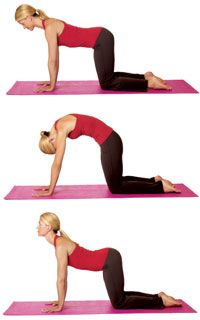 After the muscle tissue has been heated, gentle stretching exercises can be added. The stretches need to be gentle so as not to tear any of the new fiber tissue that is being laid down. Static stretches that gradually stretch the extensors can be performed with care not to take the stretch into pain. Good examples of back extensor stretches include figure four, sit and reach, and cat stretch.
After the muscle tissue has been heated, gentle stretching exercises can be added. The stretches need to be gentle so as not to tear any of the new fiber tissue that is being laid down. Static stretches that gradually stretch the extensors can be performed with care not to take the stretch into pain. Good examples of back extensor stretches include figure four, sit and reach, and cat stretch.
Once the muscles have been gently stretched, isometric back extension exercises can be performed. These are exercises that contract the extensor muscles of the back without allowing any movement of the spine. Isometric contractions can be held for up to 10 seconds and then released. These can be repeated throughout the day.
The “posterior pelvic tilt” isometric exercise is a good beginning exercise for this phase. The individual lies down on their back with their hips and knees bent and their feet on the floor. The individual presses their lower back to the floor and holds the contraction against the floor for 10 seconds and then relaxes. This can be repeated every hour up to the patient’s tolerance.
Intermediate Exercises (Proliferation Phase – 7 – 14 days)
Once isometric contractions can be sustained pain free and the individual has gained some mobility through the initial stretching exercises, the individual is ready to begin adding additional stretching exercises (rotation and lateral bends) and concentric exercises (strength exercises with movement).
Care needs to be taken to ensure that all stretching exercises are performed through pain free ranges of motion. In this phase, trunk rotation exercises can begin. One rotation exercise is to have the individual lie on his/her back. While keeping the shoulder blades on the floor, the individual can rotate the right leg over the left leg providing a stretch to the back. This same stretch can be performed in the opposite direction.
Lateral bends can also be performed during this phase. The individual starts in a standing position with arms straight down. The individual then slides one hand down the side of his/her leg until a stretch is felt. The same stretch can be performed on the opposite side. Other stretches for the back include lumbar rock, spinal twist, knees-to-chest, and lateral trunk stretch (Houglum, P. Therapeutic Exercise for Athletic Injuries, 200).
Concentric exercises can be performed for all of the muscles located in and around the spine including the rectus abdominis, internal and external obliques, and erector spinae. Although the individual strained only his/her back muscles, strengthening the muscles all around the spine is important for a full recovery.
Exercises that strengthen the abdominal muscles include abdominal crunches and abdominal crunches with a twist (elicit contractions from the obliques). Back extensor muscles can be targeted through prone supermans, and alternating arm and leg extensions while on knees and hands.
A number of exercises to strengthen the core muscles can also be performed utilizing a therapy ball including bridges, supine leg lift, hip rotation, back extension in a prone position, and ball lifts (Houglum, P. Therapeutic Exercise for Athletic Injuries, 200)
Advanced Exercises (Maturation Phase)
The last phase of rehabilitation is to add power exercises to the protocol. Power exercises are specifically designed to add a “speed” component to the strength component that has already been regained. Any strength exercise can become a “power” exercise if the exercise is done explosively through either the addition of speed through the range of motion, maximum height (vertical jump), and/or distance (medicine ball work).
Plyometric exercises are classified as power exercises, but care must be taken to ensure that the athlete is strong enough and fit enough to perform them safely.
When to See a Sports Medicine Doctor
Everyday hundreds of athletes sustain suden trauma injuries – or an injury due to overuse. There are definately signs when you should seek an appointment with a sports medicine doctor to diagnose the injury and establish a treatment plan. These signs can include:
- Swelling. Many sport injuries result in significant swelling of a joint, such as a ankle or knee. If the swelling is accompanied by bruising, tenderness, or a deformed limb, it could be a sign of a broken bone and time to see a doctor.
- Inability to Bear Weight or put pressure on the Joint. If you’re unable to bear weight or put pressure on a joint, you may have a serious orthopedic injury.
- Lingering Pain After a Period of Rest. Rest your body and injury for a week and if the pain still continues it’s time to see a sports medicine doctor.
- Inability to Move or Bend a Joint. If you are unable to bend or move a joint, such as an ankle, elbow, wrist, shoulder, back or knee, the cause is likely an orthopedic injury and you should seek care from a dooctor.
Treatment of your sports injury
If you think you suffered a sports injury it’s important to imeddiately start using the P.R.I.C.E. principle. The acronym stands for: Protection, Rest, Ice, Compression, Elevation.
The principles of P.R.I.C.E. should be used for the first 48 – 72 hours immediately after the injury. The goal during this time frame is to control the amount of swelling to the injured area, prevent further injury, and reduce pain. Following these principles can effectively reduce the amount of swelling in an injured area thereby reducing the amount of time required for rehabilitation.
Returning to sport
The purpose of return to play criteria is twofold. The first is to ensure that the injured muscle has recovered sufficiently and that the muscle is ready to respond to the demands of the sport. Second, and just as important, is for the athlete to test the muscle under controlled circumstances for the purpose of regaining confidence in his/her body’s ability to handle the demands of his/her sport.
An athlete is ready to return to play when he/she has full pain free range of motion of the trunk in all three planes (flexion/extension, rotation, and lateral flexion left and right) with full strength in all of the muscles in and around the spine. Once this is achieved, the athlete is ready to perform sport specific functional activities to ensure that his/her body is ready for the dynamic demands of the sport.
Designing a sport-specific functional progression begins by analyzing the skills and demands of the sport. Specific basic skills are selected and the athlete is asked to perform those skills beginning at 50% of maximum intensity. If the athlete can perform all of the basic skills at 50% intensity, then the athlete can gradually increase the intensity to 65%, 75%, 85%, and then maximum intensity. When sport-specific activities can be performed pain-free at full speed, the athlete is then ready to return to play.
Get a Virtual Sports Specialized appointment within 5 minutes for $29
 When you have questions like: I have an injury and how should I manage it? How severe is it and should I get medical care from an urgent care center or hospital? Who can I talk to right now? SportsMD Virtual Urgent Care is available by phone or video anytime, anywhere 24/7/365, and appointments within 5 minutes. Learn more via SportsMD’s Virtual Urgent Care Service.
When you have questions like: I have an injury and how should I manage it? How severe is it and should I get medical care from an urgent care center or hospital? Who can I talk to right now? SportsMD Virtual Urgent Care is available by phone or video anytime, anywhere 24/7/365, and appointments within 5 minutes. Learn more via SportsMD’s Virtual Urgent Care Service.
References
- Dunn, I., Proctor, M., & Day, A. (2006). Lumbar spine injuries in athletes. Neurosurgical Focus 21(4).
- Floyd, R.T. (2009). Manual of Structural Kinesiology. (17th Ed.). McGraw Hill: New York, NY.
- Houglum, P. (2005). Therapeutic Exercise for Musculoskeletal Injuries. (2nd Ed.). Human Kinetics: Champaign, IL.
- Levangie, P.K. & Norkin, C. (2001). Joint Structure and Function: A comprehensive Analysis. (3rd Ed). F.A. Davis: Philadelphia, PA.
- Prentice, W. (2010). Essentials of Athletic Injury Management. (8th Ed.). McGraw Hill: New York, NY.

